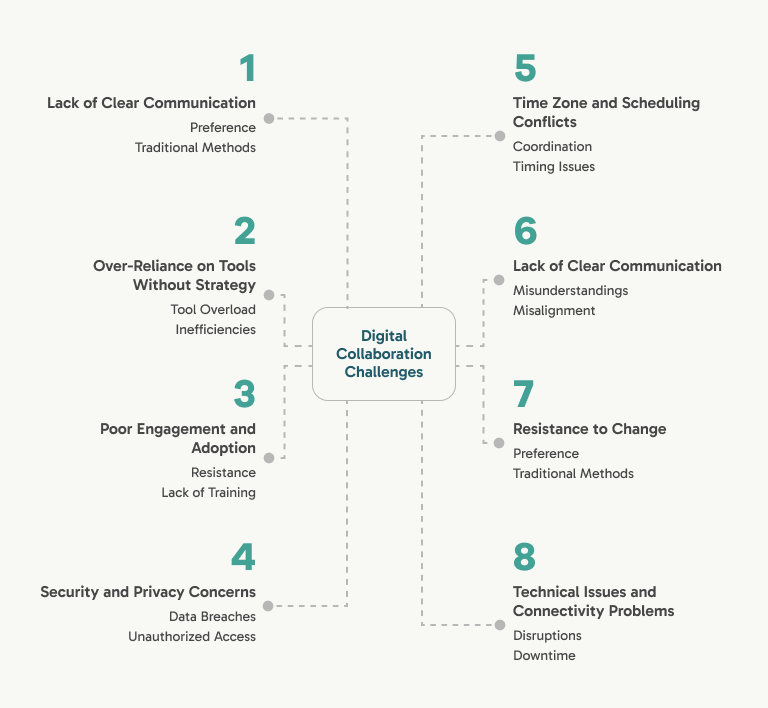project management · Mar 25, 2025
10 Benefits and Best Practices to Make Digital Collaboration Work

In today’s fast-paced digital world, teams are no longer confined to office spaces. With remote work on the rise and global teams becoming the norm, digital collaboration has transformed how people communicate, plan, and execute projects.
But while digital collaboration offers numerous benefits, it also presents challenges that organizations must address. This blog will explore the advantages of digital collaboration, common pitfalls, and best practices to ensure its success.
What is Digital Collaboration?
Digital collaboration refers to the use of digital tools and platforms that enable individuals or teams to work together efficiently, regardless of their location.
Unlike traditional collaboration, which relies heavily on in-person meetings, phone calls, and physical documents, digital collaboration enables real-time interactions through cloud-based solutions, instant messaging, video conferencing, and collaborative workspaces.
For example, a marketing team spread across different continents can brainstorm ideas using shared documents, conduct virtual meetings, and track project progress using digital collaboration tools like Quire.
This seamless interaction enhances productivity and ensures that team members remain aligned, even when collaborating remotely.
10 Benefits of Digital Collaboration
Digital collaboration offers several advantages that traditional methods cannot match. Here are some of the most significant benefits:
1. Increased Productivity
Effective digital collaboration optimizes workflows by reducing downtime and eliminating bottlenecks. Instead of waiting on email responses or coordinating multiple schedules for meetings, teams can work simultaneously on shared tasks, ensuring steady progress without interruptions.
For example, a marketing team preparing a campaign can utilize a collaborative workspace to assign tasks, track progress, and provide instant feedback. This reduces miscommunication, minimizes delays, and allows the team to meet deadlines more efficiently while maintaining high-quality results.
2. Better Accessibility and Flexibility
Remote work has become essential rather than optional. Digital collaboration enables team members to contribute from anywhere with just a laptop, a stable internet connection, and the right tools. Whether working from home, traveling, or in different time zones, they can stay connected through cloud-based platforms, ensuring seamless teamwork.
For example, a remote development team can use project management software to assign tasks, video conferencing for daily check-ins, and cloud storage for real-time file sharing. By accessing shared dashboards, tracking updates, and providing instant feedback, they collaborate efficiently without being in the same physical location. This flexibility promotes a healthier work-life balance, enhances job satisfaction, and ultimately improves productivity.
3. Enhanced Transparency
Digital collaboration tools ensure that project progress, deadlines, and responsibilities are clearly visible to all stakeholders, from team members to managers and clients. This transparency eliminates confusion, reduces unnecessary follow-ups, and fosters accountability within the team.
For instance, in a software development project, a shared task board allows developers to update their progress, managers to track pending tasks, and clients to review milestones in real-time. With automated notifications and status updates, everyone stays informed without constant check-ins, ensuring smoother workflows and fewer misunderstandings.
4. Cost Savings
Companies can significantly reduce costs associated with travel, office space, and printed materials by implementing digital collaboration technology. Instead of flying employees for meetings, organizations can use video conferencing and document-sharing tools to conduct discussions effectively.
Additionally, fewer overhead costs mean businesses can allocate resources to innovation, employee benefits, or marketing initiatives, further enhancing growth.
5. Seamless Cross-Team Communication
In large organizations, teams often work in silos due to departmental separation, different priorities, and a lack of shared communication channels. Marketing may focus on brand messaging, sales on closing deals, and development on building the product—all without a clear understanding of each other’s timelines and needs. This fragmentation can lead to delays, misalignment, and duplicated efforts.
For example, during a product launch, marketing needs promotional materials, sales requires product knowledge, and customer support must prepare for inquiries. A digital collaboration platform ensures that all departments stay aligned by centralizing updates, feedback, and progress tracking. When marketing adjusts a campaign based on new product features, sales and support teams are immediately informed, preventing miscommunication and ensuring a smooth launch.
6. Real-Time Collaboration
Traditional collaboration often leads to version control issues, scattered feedback, and lost data buried in long email threads. Digital collaboration platforms solve these problems by enabling real-time document editing, where multiple users can work on the same file simultaneously, see updates instantly, and leave comments in context.
For example, in a content creation project, a marketing team using Quire’s shared workspace can draft a campaign proposal, while designers add visuals and managers provide feedback—all within the same document. Changes are automatically saved, eliminating confusion over file versions and ensuring that everyone is working with the most up-to-date information. This seamless workflow reduces delays and enhances team efficiency.
7. Scalability for Growing Teams
As companies grow, collaboration becomes more complex, with more team members, projects, and cross-departmental communication needs. Digital collaboration tools scale by offering features such as advanced task management, permission controls, and automation, ensuring that workflows remain efficient even as teams expand.
For instance, a startup using Quire to manage tasks with a small team can continue using the platform as it grows into a large enterprise. As more employees join, the company can create multiple project workspaces, assign role-based permissions, and integrate external tools like Google Drive or Slack. These scalable features prevent bottlenecks, maintain organization, and ensure that teams can collaborate seamlessly, no matter the company's size.
8. Security and Data Backup
Unlike physical documents that can be lost, damaged, or misplaced, digital collaboration platforms provide secure cloud storage with automated backups, ensuring that valuable data is always protected and retrievable.
For businesses handling sensitive client information—such as law firms managing confidential case files or healthcare providers storing patient records—encrypted cloud solutions safeguard data from breaches. These platforms implement multi-layer security measures, including end-to-end encryption, multi-factor authentication (MFA) for access control, and role-based permissions to restrict data visibility. Additionally, automatic version history and regular backups prevent data loss, ensuring that even accidental deletions or cyber threats do not compromise critical information.
9. Improved Innovation and Creativity
With digital collaborative brainstorming tools, mind maps, and shared workspaces, teams can generate ideas more effectively because digital collaboration tools provide a centralized space for brainstorming, instant feedback, and seamless iteration. Features like virtual whiteboards, shared documents, and real-time commenting enable team members to contribute ideas, refine concepts, and build on each other’s input—regardless of their location.
For example, a product development team using an online brainstorming tool can simultaneously add ideas to a shared board, discuss suggestions via video calls, and vote on the best concepts. This immediate interaction eliminates delays caused by email exchanges and ensures that creativity flows uninterrupted, leading to more innovative solutions.
10. Easier Performance Tracking and Reporting
One of the biggest advantages of digital collaboration is the ability to track team performance in real time. Unlike traditional methods that rely on manual updates or scattered reports, digital tools automatically collect data on task progress, deadlines, and workload distribution. This visibility allows managers to make data-driven decisions, identify inefficiencies, and proactively address potential issues before they escalate.
For example, Quire provides visual insights into task completion rates, overdue assignments, and team workload. With these analytics, managers can spot bottlenecks, balance responsibilities, and adjust timelines as needed—ensuring smoother collaboration and improved overall productivity.
Jobs That Leverage Digital Collaboration
Many professions rely on digital collaboration to streamline workflows, improve communication, and enhance productivity. Here’s how different roles benefit from these tools:
- Remote Project Managers – Oversee distributed teams by coordinating tasks, tracking progress, and ensuring deadlines are met through project management software. These tools eliminate the need for constant email updates, allowing managers to assign responsibilities, set priorities, and monitor team performance in one centralized space.
- Software Developers – Use cloud-based repositories like GitHub to collaborate on coding projects in real time. Version control, automated testing, and issue tracking ensure that multiple developers can work on the same codebase without conflicts, speeding up development cycles and reducing errors.
- Marketing Teams – Manage complex campaigns across different locations by utilizing shared content calendars, real-time document editing, and collaboration tools. This ensures seamless coordination between designers, copywriters, and strategists, preventing miscommunication and keeping projects on schedule.
- Customer Support Teams – Rely on shared platforms to track customer queries, update ticket statuses, and provide timely assistance. Centralized knowledge bases and chat integrations enable support agents to access accurate information instantly, improving response times and customer satisfaction.
- Consultants and Freelancers – Work with multiple clients remotely using digital collaboration tools for file sharing, virtual meetings, and task tracking. These platforms eliminate the need for physical meetings, making it easier to manage projects, share updates, and receive feedback efficiently.
By leveraging digital collaboration, these professionals can work more efficiently, stay connected with teams and clients, and ensure smooth operations—regardless of location.
8 Reasons Why Digital Collaboration Fails

Despite its benefits, digital collaboration can sometimes fail due to the following reasons:
1. Lack of Clear Communication
Without a well-defined communication strategy, teams may struggle with misunderstandings, missed deadlines, and misalignment of goals. The absence of face-to-face interactions can make it difficult to interpret tone and intent, leading to confusion and frustration among team members.
2. Over-Reliance on Tools Without Strategy
Simply implementing digital tools does not automatically improve collaboration. Without a structured workflow and clear guidelines on how to use these tools effectively, teams may end up with tool overload, where too many platforms create inefficiencies rather than streamlining work.
3. Poor Engagement and Adoption
Employees may resist using new collaboration tools due to unfamiliarity, lack of training, or preference for traditional working methods. If team members are not properly onboarded or motivated to engage with digital platforms, productivity can suffer.
4. Security and Privacy Concerns
While digital collaboration platforms offer secure cloud storage and encrypted solutions, they also introduce potential security risks if not properly managed. Storing sensitive company data on these platforms means that teams must ensure strong security measures are in place to prevent data breaches, unauthorized access, or accidental leaks.
5. Time Zone and Scheduling Conflicts
Global teams often face challenges in coordinating meetings across multiple time zones. If not managed properly, this can lead to delays in decision-making, reduced team cohesion, and frustration among employees who struggle to find overlapping work hours.
6. Lack of Accountability and Visibility
Without clear task assignments and tracking mechanisms, digital collaboration can lead to a lack of accountability. Team members may struggle to understand their responsibilities, and managers may find it difficult to assess progress without micromanaging.
7. Resistance to Change
Some employees may prefer traditional collaboration methods due to familiarity and comfort with established routines. The fear of change, lack of confidence in new tools, or concerns over the learning curve can lead to resistance when adopting digital workflows. Additionally, some may worry about the effectiveness of new tools or feel overwhelmed by the shift in how tasks are managed.
This resistance can slow down the transition to a more efficient collaboration model, as employees may take longer to adopt and fully integrate new digital tools, ultimately hindering overall productivity. Addressing these concerns through training, support, and clear communication can help ease the shift and promote smoother adoption.
8. Technical Issues and Connectivity Problems
Reliance on digital platforms means that any technical disruptions—such as software downtime, connectivity issues, or integration failures—can bring collaboration to a halt. Organizations must have contingency plans to address these potential setbacks.
Quire: Your Digital Collaboration Tool
Quire is designed to help organizations overcome digital collaboration challenges and achieve seamless teamwork. With Quire’s task hierarchy, teams can break down large projects into smaller, manageable tasks, assign responsibilities, and track progress in real-time.
- Marketing Team: A global agency improved campaign execution by 40% using Quire’s structured task management and calendar integration, ensuring alignment across multiple time zones.
- Software Development Team: By integrating Quire with GitHub, a remote development team reduced project delays and enhanced collaboration speed by 30%, allowing for more agile software releases.
- Event Planning Team: Quire streamlined vendor coordination and scheduling, cutting down planning time by 25% and ensuring all event logistics were smoothly managed.
- Nonprofit Organizations: A global nonprofit leveraged Quire to coordinate volunteers across different countries, increasing project efficiency and impact by 50%.
Final Thoughts
Digital collaboration is no longer optional—modern teams need to thrive. By leveraging the right tools, implementing clear strategies, and fostering a collaborative culture, organizations can unlock new levels of productivity and efficiency. Whether your team is remote, hybrid, or office-based, platforms like Quire provide the structure needed to ensure seamless collaboration. Embrace digital collaboration today and future-proof your team's success!

